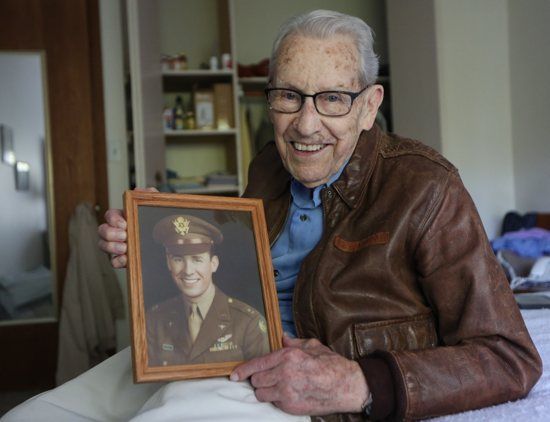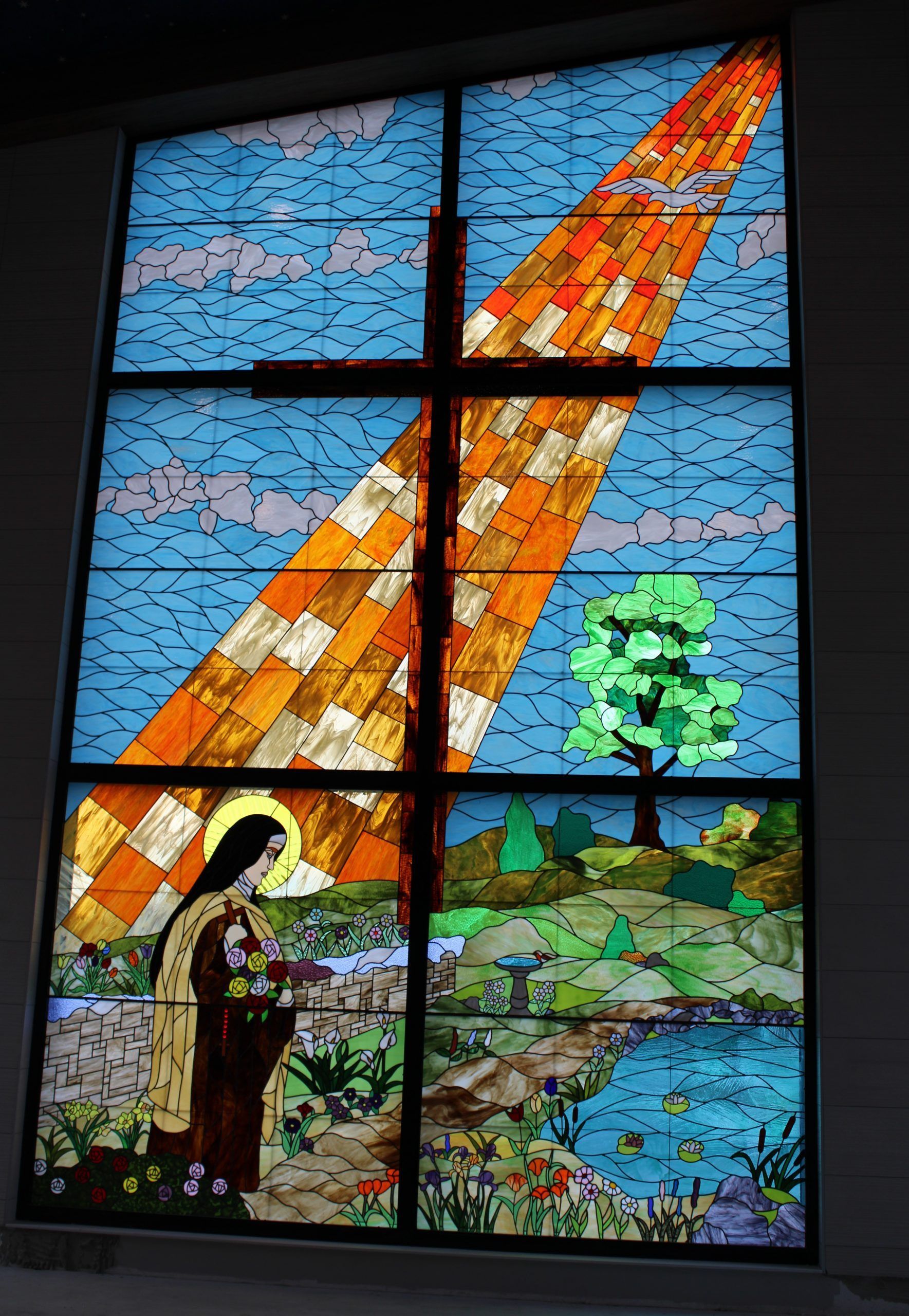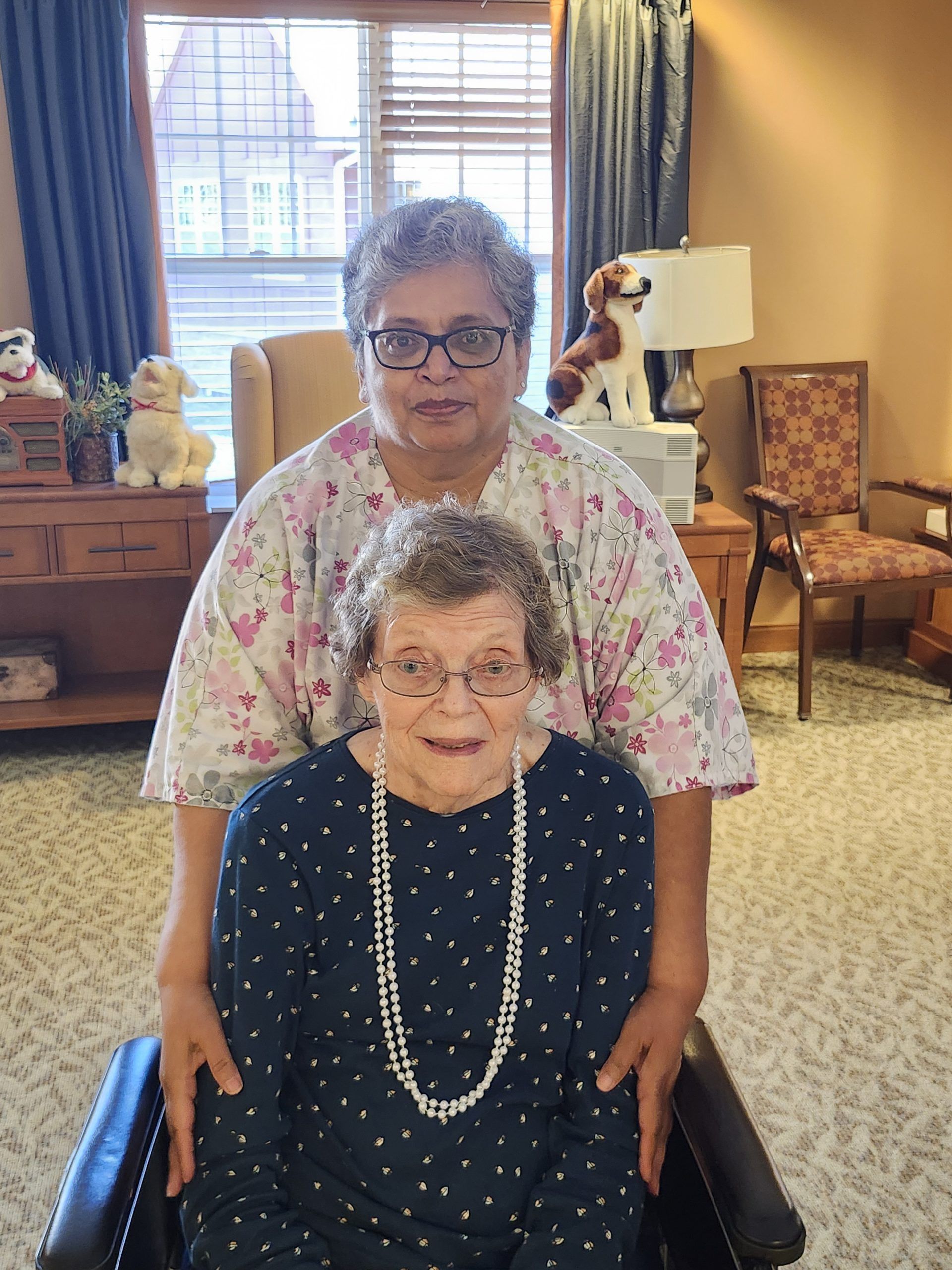
Saint Therese Resident credits St. Therese of Lisieux for WWII survival
The Catholic Spirit
Dave Hrbacek | October 30, 2019
A German Messerschmitt fighter plane was bearing down on
Don Stoulil’s B-17 bomber as he flew a mission during World War II.
Stoulil, the pilot, looked out the windshield of his cockpit and saw the enemy plane zooming straight at him with machine guns blazing.
“This is it,” he thought, as he braced for the barrage of bullets that he expected to blast through the glass and tear into his body.
It didn’t happen. Not one piece of lead penetrated the cockpit. Stoulil, a member of Sacred Heart in Robbinsdale, recently offered his explanation during an interview with The Catholic Spirit. He believes he had a layer of protection no German machine gun could penetrate — a first-class relic of St. Therese of Lisieux. Tucked into the pocket of his uniform pants, it was with him on every mission. He believes St. Therese kept him alive in the cockpit during six months of bombing runs that ended in 1944 when he reached the end of his tour of duty and returned to the U.S.
The then-22-year-old got the relic from a chaplain, Father Edmund Skoner, at an airfield in Molesworth, England, shortly after arriving in December 1943. After surviving 31 bombing missions into Germany, Stoulil came to believe that St. Therese was watching over him. He escaped several close calls and saw other planes flying near his get hit and go down. Nary a bullet touched his cockpit. Only once did a member of his 10-man crew get injured. None were killed.
“St. Therese, oh, she took care of us — absolutely,” said Stoulil, 98. “She means just about everything because I wouldn’t be here now if it wasn’t for St. Therese.”
Don Stoulil |Army Air Corps Veteran and Resident of Saint Therese of New Hope
‘The Little Flower’
Today, the 98-year-old, who married after the war and had four children with his late wife, Shirley, is as passionate as ever about his favorite saint, “The Little Flower.” Fittingly, he lives at a facility in New Hope that bears her name: St. Therese of New Hope. He has told his story numerous times, both to Sacred Heart parishioners and students at Sacred Heart Catholic School.
Stoulil crossed paths with the relic by chasing his boyhood dream of becoming a pilot. He had what he called “a romance with the clouds.” Growing up in Olivia about two hours west of the Twin Cities, he often would run out of his house to watch World War I-era planes fly overhead.
After graduating from high school in 1938, he enlisted in the Army National Guard in 1940 with the hope of becoming a pilot. He was placed into the regular Army after the Japanese attack on Pearl Harbor Dec. 7, 1941. Transferred to Camp Haan in California, he noticed a nearby aviation training facility called March Field.

“I used to watch those B-17s take off over at March Field,” he said. “My body was in Camp Haan; my heart was over there across the road at March Field. I wanted to get in the (Army) Air Corps.”
It took some persistence. Initially, he was assigned to operate anti-aircraft artillery. That landed him in Alaska, where U.S. forces were anticipating a Japanese attack. For several months, it looked as though his military tour would involve firing at enemy fighter planes.
“But, I still had my heart in the air,” he said. “I wanted to do that more than anything else in the world.”
With the help of a commanding officer, he was able to go to Anchorage to apply for aviation cadet training in the Army Air Corps (now called the Air Force). He was rejected the first time because of a medical condition, but eventually passed in June 1942. The news “was like going to heaven,” he said.
Once in flight school, he chose to be a bomber pilot and was assigned to the 303rd Bomb Group in Molesworth, England.
Sharing his story
There he met the chaplain who gave him the relic. The details are still fresh in his mind, and eighth-graders at Sacred Heart Catholic School in Robbinsdale heard them over several years during presentations Stoulil gave at the school.
“It was awesome just to be able to listen to him talk,” said Alex Bowback, 24, who heard Stoulil’s presentation in 2009 as an eighth-grader. “If I (would have) had a recording device then, I would have wanted to record his whole story. It was admirable to hear him speak about his experiences.”
Bowback remembers Stoulil bringing his leather flight jacket. Bowback said his best friend even got to try it on. The jacket is one of Stoulil’s prized possessions, and he still fits into it today.
Stoulil was first invited to speak at the school by a teacher, Julie Harty, who thought he would be a good fit for middle schoolers. He landed in the classroom of social studies teacher Pat Greshwalk, who has since retired. She said he was a hit each time with the students — and with her.
“I thought he was just fascinating because … he took you there, back to World War II,” Greshwalk said. “When you hear it from a person who actually experienced it, it’s real. … You could feel the fear and the bravery and the tenaciousness of these pilots.”
Principal Karen Bursey, who also taught at the school and went there herself, knew Stoulil from childhood because she was friends with one of his daughters. She said she was “thrilled” when she found out he had agreed to come to the school to share his story.
“Don is such an animated person, and his memory is so sharp,” said Bursey. “His eyes just sparkled when he talked about (his experiences). And, he made it interesting for the kids, and he knew the stories that they would enjoy. Classes were only 50 minutes, and when class was up, they wanted to keep going with Don instead of going on to their next (class).”
Stoulil wants to make sure his story — especially the part about the relic — lives on. After carrying the relic in his pocket for decades after coming home, he gave it to the pastor of Sacred Heart, Father Bryan Pedersen, three years ago. The two met just a week after Father Pedersen came to Sacred Heart in 2008. They forged a friendship through weekly breakfasts at a local restaurant after morning Mass, and built a trust that motivated Stoulil to place the relic in his pastor’s care.
“I just felt humbled that he would want me to have that relic,” Father Pedersen said.
Meanwhile, Stoulil continues his devotion to St. Therese. He currently is reading her autobiography, “The Story of a Soul,” and also makes regular visits to a smaller, secondary prayer space at his care facility called Little Flower Chapel. He goes to this chapel for Mass twice a week and tries to stop by daily to acknowledge the saint’s help in the cockpit of his B-17.
“I go by there and I’ll say, ‘Thank you, Therese, for 31,’” he said. “She got me through those 31 missions without a scratch. There were some mighty, mighty, mighty close calls. If it hadn’t been for her taking care of me, I wouldn’t be here right now.”
Father Pedersen is glad to have the chance to know someone from what is known as The Greatest Generation. The priest said Stoulil is “a man of service, and dedicated to country, to family and to his faith, the Catholic faith in particular. We need more men like Don Stoulil today. Our world, our country would be far better off.”
About
At Saint Therese, our heartfelt purpose since 1968 has been a people first approach to living well by providing senior care and services where every life we touch feels welcomed, respected, and heard. We achieve this by doing ordinary things with extraordinary love every single day. Contact us to learn more.







